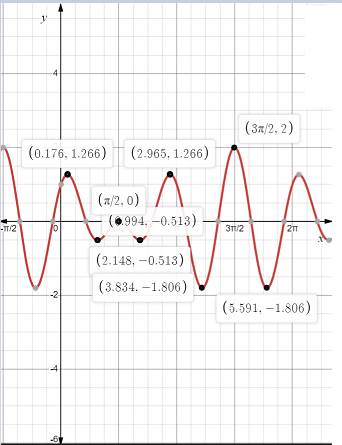
a.
To identify: The interval in which the function
a.
Answer to Problem 12RE
The function is increasing in the interval
Explanation of Solution
Given information:
The given function is
Consider the given function.
Calculate the derivative of the function.
Now determine the critical points.
By putting
So, the critical points are:
Now draw the table 1:
| Intervals | |||||
| Sign of derivative | |||||
| Behavior of y | Increasing | Decreasing | Increasing | Decreasing | Increasing |
| Intervals | |||||
| Sign of derivative | |||||
| Behavior of y | Decreasing | Increasing | Decreasing | Increasing |
Thus, from the table 1 it can be observed that the function is increasing in the interval
b.
To identify: The interval in which the function
b.
Answer to Problem 12RE
The function is decreasing in the interval
Explanation of Solution
Given information:
The given function is
Consider the given function.
It is known that the table 1 is
| Intervals | |||||
| Sign of derivative | |||||
| Behavior of y | Increasing | Decreasing | Increasing | Decreasing | Increasing |
| Intervals | |||||
| Sign of derivative | |||||
| Behavior of y | Decreasing | Increasing | Decreasing | Increasing |
Thus, from the table 1 it can be observed that the function is decreasing in the interval
c.
To identify: The interval in which the function
c.
Answer to Problem 12RE
The function is concave up in the interval
Explanation of Solution
Given information:
The given function is
Consider the given function.
Determine the second derivative and equate with zero.
So, the points where double derivative is zero:
Now draw the table 2:
| Intervals | |||||
| Sign of derivative | |||||
| Behavior of y | Concave down | Concave up | Concave down | Concave up | Concave down |
| Intervals | |||||
| Sign of derivative | |||||
| Behavior of y | Concave up | Concave down | Concave up | Concave down |
From the table 2 it can be observed that the function is concave up in the interval
d.
To identify: The interval in which the function
d.
Answer to Problem 12RE
The function is concave down in the interval
Explanation of Solution
Given information:
The given function is
Consider the given function.
It is known that the table 2 is:
| Intervals | |||||
| Sign of derivative | |||||
| Behavior of y | Concave down | Concave up | Concave down | Concave up | Concave down |
| Intervals | |||||
| Sign of derivative | |||||
| Behavior of y | Concave up | Concave down | Concave up | Concave down |
From the table 2 it can be observed that the function is concave down in the interval
Now draw the graph of the function.

Thus, answer is verified from the graph.
e.
To identify: The local extreme values of the function
e.
Answer to Problem 12RE
The local extrema at
Explanation of Solution
Given information:
The given function is
Consider the given function.
From the table 1 it can be observed that the function is concave down in the interval
(e) From the table (1) we have
Note that the local extrema at
f.
To identify: The inflection points of the function
f.
Answer to Problem 12RE
The inflection points are:
Explanation of Solution
Given information:
The given function is
Consider the given function.
There are 8 inflection points given by
Chapter 4 Solutions
Advanced Placement Calculus Graphical Numerical Algebraic Sixth Edition High School Binding Copyright 2020
- 3) If a is a positive number, what is the value of the following double integral? 2a Love Lv 2ay-y² .x2 + y2 dadyarrow_forward16. Solve each of the following equations for x. (a) 42x+1 = 64 (b) 27-3815 (c) 92. 27² = 3-1 (d) log x + log(x - 21) = 2 (e) 3 = 14 (f) 2x+1 = 51-2xarrow_forward11. Find the composition fog and gof for the following functions. 2 (a) f(x) = 2x+5, g(x) = x² 2 (b) f(x) = x²+x, g(x) = √√x 1 (c) f(x) = -1/2) 9 9(x) = х = - Xarrow_forward
- practice problem please help!arrow_forward13. A restaurant will serve a banquet at a cost of $20 per person for the first 50 people and $15 for person for each additional person. (a) Find a function C giving the cost of the banquet depending on the number of people p attending. (b) How many people can attend the banquet for $2000?arrow_forwardAlt Fn Ctrl 12. Find functions f and g such that h(x) = (fog)(x). (a) h(x) = (x² + 2)² x+1 (b) h(x) = 5 3arrow_forward
 Calculus: Early TranscendentalsCalculusISBN:9781285741550Author:James StewartPublisher:Cengage Learning
Calculus: Early TranscendentalsCalculusISBN:9781285741550Author:James StewartPublisher:Cengage Learning Thomas' Calculus (14th Edition)CalculusISBN:9780134438986Author:Joel R. Hass, Christopher E. Heil, Maurice D. WeirPublisher:PEARSON
Thomas' Calculus (14th Edition)CalculusISBN:9780134438986Author:Joel R. Hass, Christopher E. Heil, Maurice D. WeirPublisher:PEARSON Calculus: Early Transcendentals (3rd Edition)CalculusISBN:9780134763644Author:William L. Briggs, Lyle Cochran, Bernard Gillett, Eric SchulzPublisher:PEARSON
Calculus: Early Transcendentals (3rd Edition)CalculusISBN:9780134763644Author:William L. Briggs, Lyle Cochran, Bernard Gillett, Eric SchulzPublisher:PEARSON Calculus: Early TranscendentalsCalculusISBN:9781319050740Author:Jon Rogawski, Colin Adams, Robert FranzosaPublisher:W. H. Freeman
Calculus: Early TranscendentalsCalculusISBN:9781319050740Author:Jon Rogawski, Colin Adams, Robert FranzosaPublisher:W. H. Freeman
 Calculus: Early Transcendental FunctionsCalculusISBN:9781337552516Author:Ron Larson, Bruce H. EdwardsPublisher:Cengage Learning
Calculus: Early Transcendental FunctionsCalculusISBN:9781337552516Author:Ron Larson, Bruce H. EdwardsPublisher:Cengage Learning





